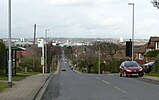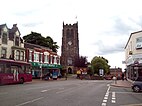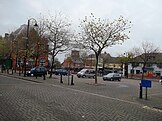Nottingham Urban Area

The Nottingham Built-up Area (BUA), Nottingham Urban Area, or Greater Nottingham is an area of land defined by the
Geography
Landmarks from top left to bottom right:
- Nottingham City Skyline
- Town Hall, Beeston
- Musters Road, West Bridgford
- St Mary's Church, Ilkeston
- Arnold Town Centre
- St Lawrence's Church, Heanor
- Clifton
- Market Square, Ripley
- Rows of housing in Long Eaton
- St Peter's Church, Ruddington
Greater Nottingham is largely within the three
The Nottingham Urban Area is bounded to the west by a narrow gap between
Sub-divisions do not always match administrative geographic boundaries; the subdivision of Clifton for example is within the Nottingham Unitary Authority city area but is subdivided by the River Trent. The Nottingham subdivision oversteps the city's borders at several locations. Together, these two subdivisions exceed the official city population (305,680 in 2011[7]) as a result, even though West Bridgford includes the counts of city suburbs Silverdale and Wilford.[8]
In the 1991 census,[9] Ilkeston was considered outside of the Nottingham Urban Area,[10] and its addition gave the BUA an 8% increase in 2001. This was due to improvements in mapping methodology by the ONS, and is chiefly responsible for the increase in sub-divisions over censuses rather than any large scale 'bricks and mortar' building,[11] as much of the area between the cities is protected green belt and wedges, restricting actual development.[6]
| Urban subdivision | Population | District | County | |||
|---|---|---|---|---|---|---|
| 1981 census | 1991 census | 2001 census | 2011 census | |||
| Nottingham | 273,300 | 270,222 | 249,584 | 289,301 | City of Nottingham
|
Nottinghamshire |
| Beeston | 64,785 | 66,626 | 66,683 | 51,479 | Broxtowe | Nottinghamshire |
| Carlton | 46,053 | 47,302 | 48,493 | 49,235 | Gedling | Nottinghamshire |
West Bridgford
|
27,463 | 33,843 | 43,395 | 45,509 | Rushcliffe | Nottinghamshire |
| Ilkeston | — | — | 37,270 | 38,640 | Erewash | Derbyshire |
| Arnold | 37,721 | 37,646 | 37,402 | 37,768 | Gedling | Nottinghamshire |
| Long Eaton | 42,285 | 44,826 | 46,490 | 37,760 | Erewash | Derbyshire |
| Hucknall | 27,463 | 29,160 | 29,188 | 32,107 | Ashfield
|
Nottinghamshire |
| Heanor | 21,863 | 22,180 | 22,620 | 25,644 | Amber Valley | Derbyshire |
| Clifton | — | — | 22,312 | 22,407 | City of Nottingham
|
Nottinghamshire |
| Ripley | 17,548 | 18,310 | 18,523 | 19,315 | Amber Valley | Derbyshire |
| Eastwood | 18,085 | 19,363 | 18,612 | 18,422 | Broxtowe | Nottinghamshire |
| Stapleford | — | — | — | 16,190 | Broxtowe | Nottinghamshire |
| Kimberley | 9,818 | 10,488 | 11,027 | 11,353 | Broxtowe | Nottinghamshire |
| Sandiacre | — | — | — | 9,600 | Erewash | Derbyshire |
| Breaston | — | 7,284 | 7,305 | 7,545 | Erewash | Derbyshire |
| Ruddington | 6,504 | 6,476 | 6,264 | 7,020 | Rushcliffe | Nottinghamshire |
| West Hallam | — | — | — | 6,016 | Erewash | Derbyshire |
| Awsworth | — | — | — | 2,517 | Broxtowe | Nottinghamshire |
| Trowell | — | — | 1,013 | 953 | Broxtowe | Nottinghamshire |
| Stanton-By-Dale | — | — | — | 505 | Erewash | Derbyshire |
| Denby Common | — | — | — | 495 | Amber Valley | Derbyshire |
| Ruddington Grange | — | — | 177 | 196 | Rushcliffe | Nottinghamshire |
| Total | 593,768 | 613,726 | 666,358 | 729,977 | ||
| Change | - | +3.36% | +8.58% | +9.55% | ||
- Awsworth, Breaston, Denby Common, Ilkeston, Ruddington Grange and West Hallam were independent areas until their inclusion in the table.
- Total of 1981 subdivision figures is 592,888, an additional 880 residents are unaccounted for in the census report[12] total.
- Up to the 2001 census, the Beeston subdivision included Stapleford and was named Beeston And Stapleford.
- Up to the 2001 census, Sandiacre was included as part of the Long Eaton subdivision.
- Up to the 1991 census, the Nottingham subdivision included Clifton.
- In the 2001 census, Stanton-By-Dale was included as part of the Ilkeston subdivision.
Greater Nottingham Partnership/D2N2
The local authorities collaborate in some ways. The
Nottingham-Derby metropolitan area
The conurbation forms a large part of the Nottingham-Derby metropolitan area, which has an estimated population of 1.5 million.[14] The urban areas of both
See also
- Derby Built-up area
- Nottingham and Derby Green Belt
- List of conurbations in the United Kingdom
- List of metropolitan areas in the United Kingdom
References
- ^ "ONS 2011 Built-up Areas - Methodology and Guidance" (PDF). www.ons.gov.uk.
- ^ "Census 2001: Key Statistics for urban areas in England and Wales" (PDF). webarchive.nationalarchives.gov.uk. Archived from the original on 5 January 2016.
{{cite web}}: CS1 maint: bot: original URL status unknown (link) - ^ "2011 Census – Built-up areas". ONS. Retrieved 3 July 2013.
- ^ "Home - Office for National Statistics". www.statistics.gov.uk.
- ^ "ONS Geography Linked Data - Nottingham BUA". statistics.data.gov.uk.
- ^ a b "Technical Assessment of the Derby Principal Urban Area Green Belt Purposes" (PDF). www.south-derbys.gov.uk. September 2012. Archived from the original (PDF) on 1 April 2017. Retrieved 31 March 2017.
- ^ "Insight web family - The people of Nottinghamshire (2015)". jsna.nottinghamcity.gov.uk.
- ^ "ONS Geography Linked Data - West Bridgford BUASD". statistics.data.gov.uk.
- ^ "National Statistics Online - Census 2001". webarchive.nationalarchives.gov.uk. Archived from the original on 18 July 2006.
{{cite web}}: CS1 maint: bot: original URL status unknown (link) - ^ "Home - Office for National Statistics". www.statistics.gov.uk.
- ^ "The UK's major urban areas" (PDF). www.ons.gov.uk. ONS.
The identification of small urban areas in the 1991 Census was less precise than in the 2001 Census. The biggest difference in method is that the distance for merger of areas of urban land increased from 50 to 200 metres
- ISBN 0116910623.
- ^ "City's regeneration body the Greater Nottingham Partnership set to be axed". Nottingham Post. 14 July 2010. Archived from the original on 5 November 2014.
- European Spatial Planning Observation Network. March 2007. p. 119. Archived from the original(pdf) on 24 September 2015. Retrieved 22 February 2010.
- ^ a b "UK Government Web Archive". webarchive.nationalarchives.gov.uk.










